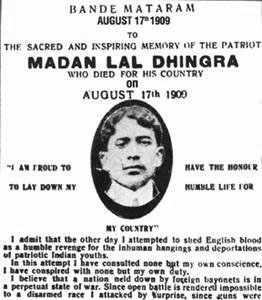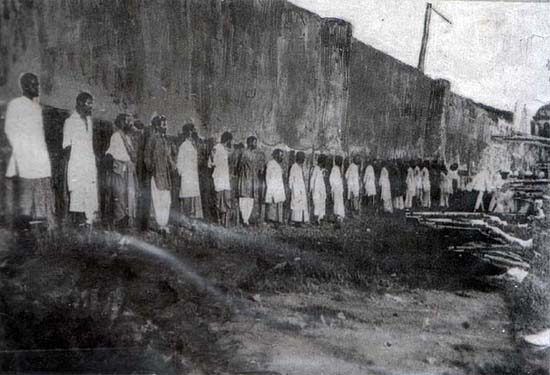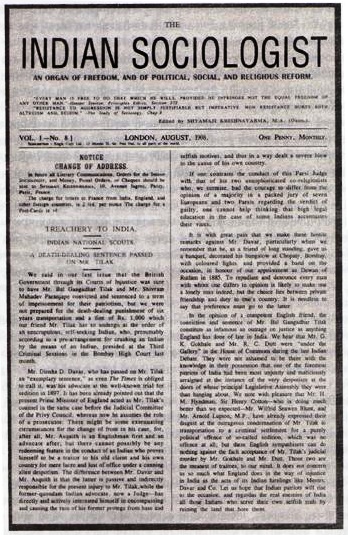|
Talvar
''Madan's Talwar'', later known as ''The Talvar'', was an early-20th-century Indian Nationalist periodical published from Berlin. Originally named after Madan Lal Dhingra, one of the heroes of the Indian independence movement who had been executed for the political assassination of William Hutt Curzon Wyllie, the publication was established in 1909 in Paris by Bhikaiji Cama. Editorial responsibilities lay with Virendranath Chattopadhyaya in Berlin. The weekly aimed to incite nationalist unrest and sought to sway the loyalty of the British Indian Army sepoys. Similar to the ''Bande Mataram'' that was published from Paris by the Paris Indian Society, it continued the message of ''The Indian Sociologist ''The Indian Sociologist'' was an Indian nationalist journal in the early 20th century. Its subtitle was ''An Organ of Freedom, and Political, Social, and Religious Reform''. The journal was edited by Shyamji Krishnavarma from 1905 to 1914, ...'' that had earlier been publ ... [...More Info...] [...Related Items...] OR: [Wikipedia] [Google] [Baidu] |
Bande Mataram (Paris Publication)
The ''Bande Mataram'' was an Indian nationalist publication from Paris begun in September 1909 by the Paris Indian Society. Founded by Madam Bhikaji Cama, the paper along with the later publication of ''Talvar'' was aimed at inciting nationalist unrest in India and sought to sway the loyalty of the Sepoy of the British Indian Army. It was founded in response to the British ban on Bankim Chatterjee's nationalist poem of Vande mataram, and continued the message of the journal ''Bande Mataram'' edited by Sri Aurobindo and published from Calcutta, and ''The Indian Sociologist'' that had earlier been published from London by Shyamji Krishna Varma Shyamji Krishna Varma (4 October 1857 – 30 March 1930) was an Indian revolutionary fighter, an Indian patriot, lawyer and journalist who founded the Indian Home Rule Society, India House and ''The Indian Sociologist'' in London. A graduate of .... References * ''Indian Unrest'', by Valentine Chirol. 2000. . pp149–151 * . p49 * ... [...More Info...] [...Related Items...] OR: [Wikipedia] [Google] [Baidu] |
Bhikaiji Cama
Bhikaiji Rustom CamaBhi''ai''- (with aspirated ''-kh-'') is the name as it appears in the biographies. Another common form is Bhi''ai''- (with unaspirated ''-k-''), as it appears on the postage stamp. The name is also frequently misspelled 'Bhikh''''-' (with missing ''-i-''), which is a male name (unlike the feminine Bhikh''''-). (24 September 1861 – 13 August 1936) or simply as, Madam Cama, was one of the prominent figures in the Indian independence movement. Bhikaiji Cama was born in Bombay (now Mumbai) in a large, affluent Parsi Zoroastrian family. Her parents, Sorabji Framji Patel and Jaijibai Sorabji Patel, were well known in the city, where her father Sorabji—a lawyer by training and a merchant by profession—was an influential member of the Parsi community. She unfurled the first version of flag of independent India on August 21, 1907, when an International Socialist Conference was being held at Stuttgart, a city in Germany. Like many Parsi girls of the time, ... [...More Info...] [...Related Items...] OR: [Wikipedia] [Google] [Baidu] |
Virendranath Chattopadhyaya
Virendranath Chattopadhyaya ( bn, বীরেন্দ্রনাথ চট্টোপাধ্যায়), alias Chatto, (31 October 1880 – 2 September 1937, Moscow), also known by his pseudonym Chatto, was a prominent Indian revolutionary who worked to overthrow the British Raj in India using armed force. He created alliances with the Germans during World War I, was part of the Berlin Committee organising Indian students in Europe against the British, and explored actions by the Japanese at the time. He went to Moscow in 1920 to develop support by the Communists for the Indian movement, including among Asians in Moscow who were working on revolutionary movements. He joined the German Communist Party (KPD). He lived in Moscow for several years in the 1930s. Arrested in July 1937 in the Great Purge, Chatto was executed on 2 September 1937. He was the brother of prominent political activist and poet Sarojini Naidu. Early life His childhood nickname was Binnie or Biren. Vir ... [...More Info...] [...Related Items...] OR: [Wikipedia] [Google] [Baidu] |
Paris Indian Society
The Paris Indian Society was an Indian nationalist organisation founded in 1905 at Paris under the patronage of Madam Bhikaji Rustom Cama, Munchershah Burjorji Godrej and S. R. Rana. The organisation was opened as a branch of the Indian Home Rule Society founded that same year in London under the patronage of Shyamji Krishna Varma. The Paris Indian Society also saw active participation from Indian nationalists who at various times were associated with the India House during its short existence. This included Virendranath Chattopadhyaya, Har Dayal, M.P.T. Acharya and Vinayak Damodar Savrkar. Other prominent Indians associated with the society included P.O. Mehta, H.M. Shah, P.C. Varma and a number of other prominent Indians in Paris at the time. The Paris Indian Society, under the strong leadership of Madam Cama, developed close links with the Socialist Party and Russian socialists in exile in Paris, and Cama herself attended the Socialist Congress of the Second International at ... [...More Info...] [...Related Items...] OR: [Wikipedia] [Google] [Baidu] |
The Talvar March 1910
''The'' () is a grammatical article in English, denoting persons or things that are already or about to be mentioned, under discussion, implied or otherwise presumed familiar to listeners, readers, or speakers. It is the definite article in English. ''The'' is the most frequently used word in the English language; studies and analyses of texts have found it to account for seven percent of all printed English-language words. It is derived from gendered articles in Old English which combined in Middle English and now has a single form used with nouns of any gender. The word can be used with both singular and plural nouns, and with a noun that starts with any letter. This is different from many other languages, which have different forms of the definite article for different genders or numbers. Pronunciation In most dialects, "the" is pronounced as (with the voiced dental fricative followed by a schwa) when followed by a consonant sound, and as (homophone of the archaic pron ... [...More Info...] [...Related Items...] OR: [Wikipedia] [Google] [Baidu] |
India House
India House was a student residence that existed between 1905 and 1910 at Cromwell Avenue in Highgate, North London. With the patronage of lawyer Shyamji Krishna Varma, it was opened to promote nationalist views among Indian students in Britain. This institute used to grant scholarships to Indian youths for higher studies in England. The building rapidly became a hub for political activism, one of the most prominent for overseas revolutionary Indian nationalism. "India House" came to informally refer to the nationalist organisations that used the building at various times. Patrons of India House published an anti-colonialist newspaper, ''The Indian Sociologist'', which the British Raj banned as "seditious". A number of prominent Indian revolutionaries and nationalists were associated with India House, including Vinayak Damodar Savarkar, Bhikaji Cama, V.N. Chatterjee, Lala Har Dayal, V.V.S. Aiyar, M.P.T. Acharya and P.M. Bapat. In 1909, a member of India House, Madan Lal D ... [...More Info...] [...Related Items...] OR: [Wikipedia] [Google] [Baidu] |
Literature Of Indian Independence Movement
Literature is any collection of written work, but it is also used more narrowly for writings specifically considered to be an art form, especially prose fiction, drama, and poetry. In recent centuries, the definition has expanded to include oral literature, much of which has been transcribed. Literature is a method of recording, preserving, and transmitting knowledge and entertainment, and can also have a social, psychological, spiritual, or political role. Literature, as an art form, can also include works in various non-fiction genres, such as biography, diaries, memoir, letters, and the essay. Within its broad definition, literature includes non-fictional books, articles or other printed information on a particular subject.''OED'' Etymologically, the term derives from Latin ''literatura/litteratura'' "learning, a writing, grammar," originally "writing formed with letters," from ''litera/littera'' "letter". In spite of this, the term has also been applied to spoken or ... [...More Info...] [...Related Items...] OR: [Wikipedia] [Google] [Baidu] |
Revolutionary Movement For Indian Independence
The Revolutionary movement for Indian Independence was the part of the Indian independence movement comprising the actions of violent underground revolutionary factions. Groups believing in armed revolution against the ruling British fall into this category, as opposed to the generally peaceful civil disobedience movement spearheaded by Mohandas Karamchand Gandhi. The revolutionary groups were mainly concentrated in Bengal, Maharashtra, Bihar, the United Provinces and Punjab. More groups were scattered across India. Beginnings Apart from a few stray incidents, the armed rebellion against the British rulers was not organised before the beginning of the 20th century. The revolutionary philosophies and movement made its presence felt during 1905 partition of Bengal. Arguably, the initial steps to organise the revolutionaries were taken by Aurobindo Ghosh, his brother Barin Ghosh, Bhupendranath Datta, Lal Bal Pal and Subodh Chandra Mullick, when they formed the Jugantar party in A ... [...More Info...] [...Related Items...] OR: [Wikipedia] [Google] [Baidu] |
The Indian Sociologist
''The Indian Sociologist'' was an Indian nationalist journal in the early 20th century. Its subtitle was ''An Organ of Freedom, and Political, Social, and Religious Reform''. The journal was edited by Shyamji Krishnavarma from 1905 to 1914, then between 1920 and 1922. It was originally produced in London until May 1907, when Krishnavarma moved to Paris. The journal was edited in Paris from June 1907, but the change of address was only announced in the September 1907 issue. Publication continued in Paris until 1914, when Krishnavarma moved to Geneva on account of the First World War. While in Geneva, he abandoned the publication under pressure from the Swiss authorities. He recommenced publication in December 1920 and continued until September 1922. Political origin The first issue contained the following statement: The appearance of a journal conducted by an Indian sociologist in England is an event likely to cause surprise in some quarters; but there are many weighty ground ... [...More Info...] [...Related Items...] OR: [Wikipedia] [Google] [Baidu] |
Sepoy
''Sepoy'' () was the Persian-derived designation originally given to a professional Indian infantryman, traditionally armed with a musket, in the armies of the Mughal Empire. In the 18th century, the French East India Company and its other European counterparts employed locally recruited soldiers within India, mainly consisting of infantry designated as "sepoys". The largest sepoy force, trained along European lines, served the British East India Company The term "sepoy" continues in use in the modern Indian, Pakistan and Nepalese armies, where it denotes the rank of private. Etymology In Persian (Aspa) means horse and Ispahai is also the word for cavalrymen. The term ''sepoy'' is derived from the Persian word () meaning the traditional "infantry soldier" in the Mughal Empire. In the Ottoman Empire the term was used to refer to cavalrymen. History The sepoys of the Mughal Empire were infantrymen usually armed with a musket and a talwar, although they some ... [...More Info...] [...Related Items...] OR: [Wikipedia] [Google] [Baidu] |
Paris
Paris () is the capital and most populous city of France, with an estimated population of 2,165,423 residents in 2019 in an area of more than 105 km² (41 sq mi), making it the 30th most densely populated city in the world in 2020. Since the 17th century, Paris has been one of the world's major centres of finance, diplomacy, commerce, fashion, gastronomy, and science. For its leading role in the arts and sciences, as well as its very early system of street lighting, in the 19th century it became known as "the City of Light". Like London, prior to the Second World War, it was also sometimes called the capital of the world. The City of Paris is the centre of the Île-de-France region, or Paris Region, with an estimated population of 12,262,544 in 2019, or about 19% of the population of France, making the region France's primate city. The Paris Region had a GDP of €739 billion ($743 billion) in 2019, which is the highest in Europe. According to the Economist Intelli ... [...More Info...] [...Related Items...] OR: [Wikipedia] [Google] [Baidu] |
Berlin
Berlin ( , ) is the capital and largest city of Germany by both area and population. Its 3.7 million inhabitants make it the European Union's most populous city, according to population within city limits. One of Germany's sixteen constituent states, Berlin is surrounded by the State of Brandenburg and contiguous with Potsdam, Brandenburg's capital. Berlin's urban area, which has a population of around 4.5 million, is the second most populous urban area in Germany after the Ruhr. The Berlin-Brandenburg capital region has around 6.2 million inhabitants and is Germany's third-largest metropolitan region after the Rhine-Ruhr and Rhine-Main regions. Berlin straddles the banks of the Spree, which flows into the Havel (a tributary of the Elbe) in the western borough of Spandau. Among the city's main topographical features are the many lakes in the western and southeastern boroughs formed by the Spree, Havel and Dahme, the largest of which is Lake Müggelsee. Due to its l ... [...More Info...] [...Related Items...] OR: [Wikipedia] [Google] [Baidu] |


.png)





